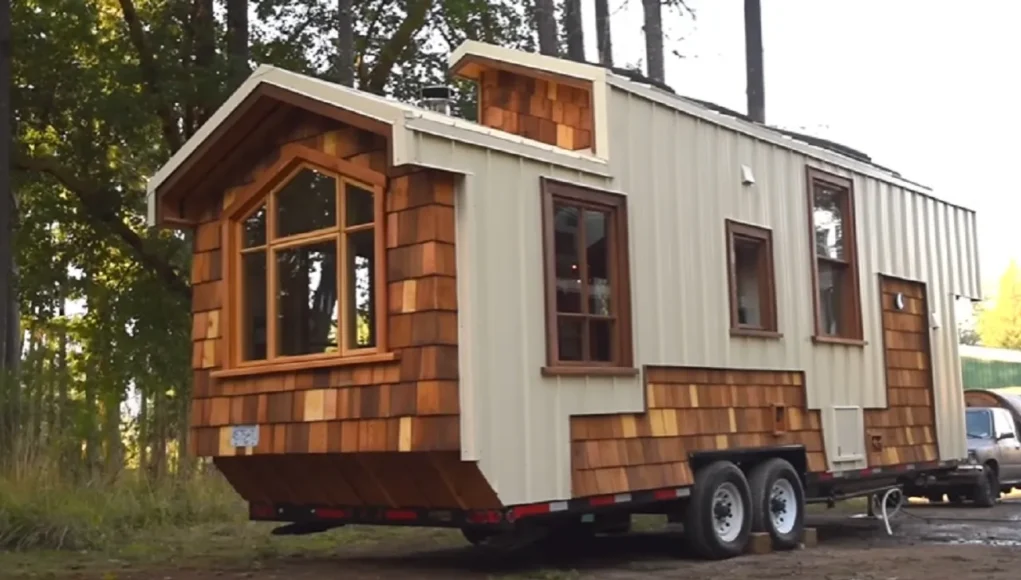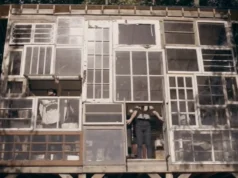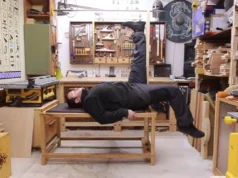The tiny house movement has rapidly become a symbol of conscious living, emphasizing sustainability, affordability, and minimalism. With its rising popularity, people have started rethinking what it means to create a home, prioritizing functionality, comfort, and reduced ecological impact. At the heart of this movement is Nick, a talented carpenter who brings his vision to life through carefully hand-crafted tiny homes. Nick’s latest project, a 26-foot-long wonder on wheels, beautifully blends modern aesthetics with traditional warmth, proving that less can truly be more.
Nick’s tiny house design is not just about reducing space—it’s a masterful blend of style and purpose, making it a stunning representation of how even the smallest footprint can feel expansive and welcoming. With a thoughtful combination of asymmetrical design elements and a mix of natural and modern materials, this home is a proof to how careful craftsmanship can transform even the tiniest space into a comfortable sanctuary.
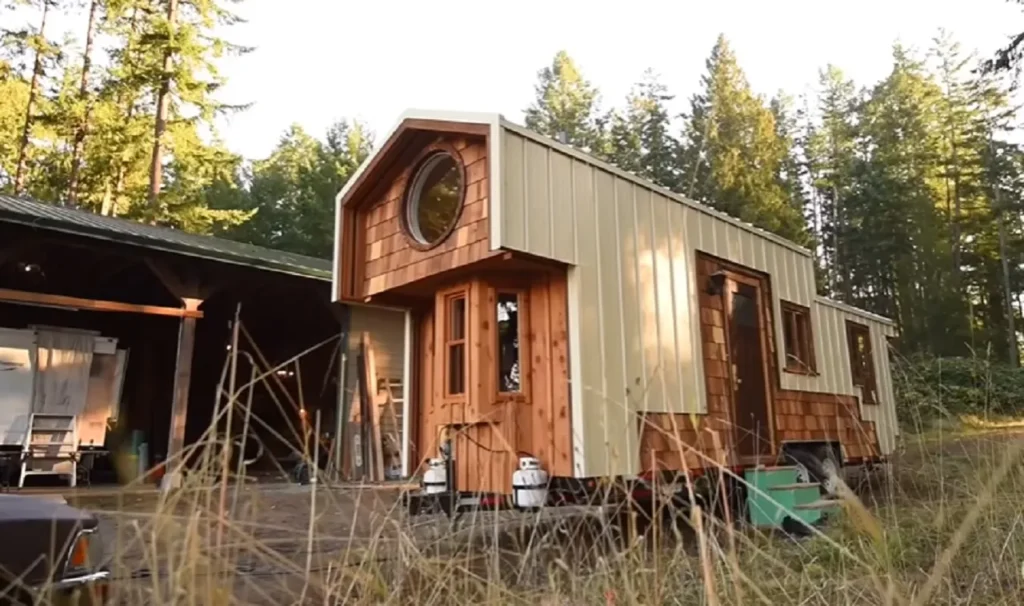
The Design of Nick’s Tiny House
Nick’s tiny house is 26 feet long and 8.5 feet wide, built on wheels to provide mobility and freedom. Its compact dimensions create a structure that is not only functional but also easy to move, catering to those who crave adventure without compromising on comfort. The mobility factor of the home means it is designed to fit the legal road width, allowing for travel without special permits, making it a convenient solution for people looking for flexibility.
The exterior of Nick’s tiny house immediately stands out with its unique mix of cedar shakes and metal siding. This blend gives the house a modern and rustic look simultaneously, celebrating natural materials while adding an industrial twist for durability and style. The choice of cedar brings warmth and a connection to nature, while the metal adds an element of strength and modernity.
What truly distinguishes this tiny home is its asymmetrical design. Unlike many symmetrical, box-like tiny homes, Nick’s approach uses angles and unconventional lines, resulting in a striking silhouette. This asymmetry isn’t just for looks—it cleverly utilizes the available space, creating visual intrigue while providing unique functional advantages, like optimized storage or better natural light flow. This thoughtful exterior design reflects a meticulous level of planning and intention, breaking away from the more conventional styles in tiny house construction.
The Craftsmanship Behind the Build
Nick’s approach to crafting his tiny house is rooted in his dedication to creating a space that feels like a home, despite its size. His attention to detail is visible in every inch of the structure, from the perfectly joined seams of the siding to the small but significant touches like built-in shelving and cleverly designed storage nooks. Each element of the house has been hand-crafted, reflecting a process that prioritizes quality over mass production.
The nooks, crannies, and corners of the house each serve a purpose. No space is wasted—every square inch is maximized to contribute to the house’s overall functionality. The kitchen features a large double sink, eschewing the usual tiny sinks that often make daily chores cumbersome. The clever inclusion of natural materials and reclaimed items gives each room a story, making it more than just a living space, but rather a work of art filled with character.
One of the key achievements in Nick’s design is his ability to balance functionality and beauty. The home is equipped with the essentials for comfortable living—yet each feature, from the staircase to the loft to the bathroom, is designed with an eye for beauty. This is seen in the deliberate use of natural light, which flows through the house, giving it an open and airy feeling despite its size. The craftsmanship of the home is in these small but significant details, which allow functionality to enhance the beauty of the space.
The Living Experience in a Tiny House
One of the most appealing aspects of this tiny house is the cozy and inviting atmosphere it creates. Despite its small footprint, the layout and design make it feel much larger than it is. The use of light colors, ample windows, and strategic layout choices like lowered platform sections helps create a visual sense of spaciousness. Nick’s use of natural wood finishes throughout adds warmth, making the interior feel like a welcoming haven rather than a cramped compartment.
Living in a tiny house means embracing a simpler lifestyle. Downsizing has numerous benefits: it reduces the cost of living, minimizes environmental impact, and forces homeowners to reconsider what they truly need. With space at a premium, only the most essential and meaningful items make it into the home, encouraging a clutter-free and intentional lifestyle.
The thoughtful design also impacts daily life positively. Built-in storage means there’s a place for everything, reducing visual clutter and helping maintain a peaceful living space. Features like a cozy loft for sleeping, an ergonomic kitchen setup, and a cleverly designed bathroom make living in a tiny house both comfortable and efficient. The house’s smart layout means that each day starts and ends in a space that feels functional yet special—a true retreat from the outside world.
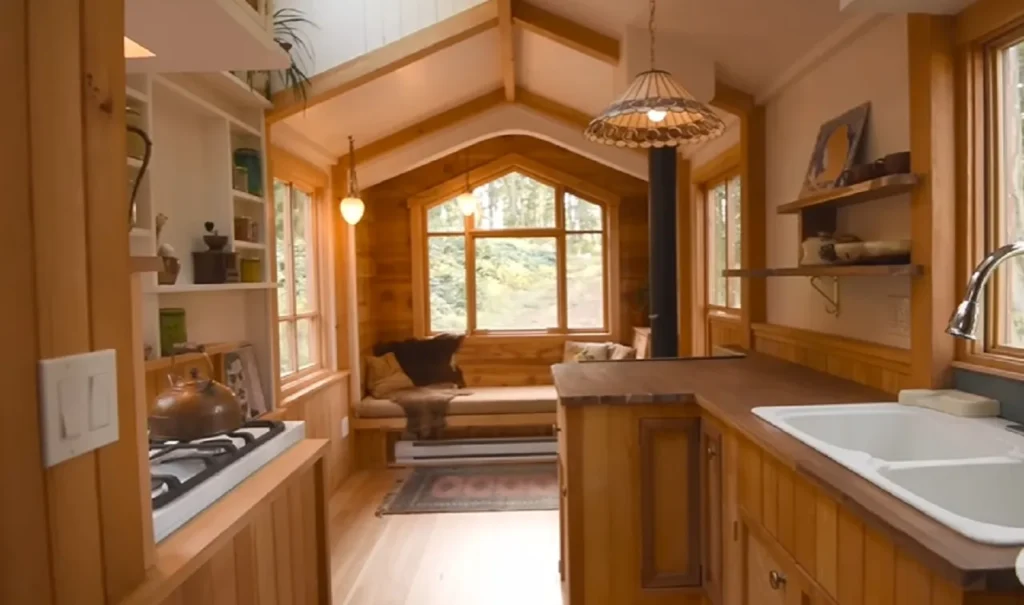
Nick’s tiny house
Nick’s tiny house is a stunning example of what can be achieved through careful craftsmanship and thoughtful design. The combination of modern materials, rustic warmth, and a focus on functionality creates a space that feels both luxurious and practical. It serves as a cue that luxury doesn’t have to come in large square footage—it can be found in the clever use of design elements, quality craftsmanship, and a space that fits your needs perfectly.
For those considering downsizing, Nick’s tiny house offers inspiration and proof that tiny living is not only feasible but can be incredibly fulfilling. The tiny house movement is more than just a trend; it’s a shift towards more sustainable and conscious living. As space becomes increasingly scarce, and as more people look for ways to simplify their lives, the future of tiny homes looks bright, blending practicality, environmental friendliness, and the comfort of a carefully designed home. Nick’s craftsmanship shows that with creativity and care, even the smallest homes can offer the biggest comforts.


